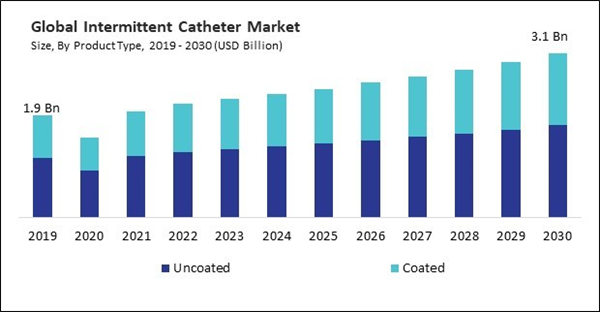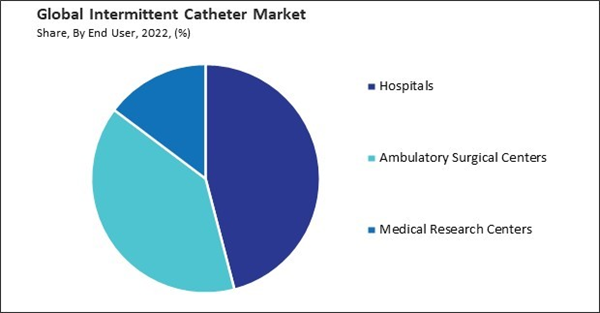The Global Intermittent Catheter Market size is expected to reach $3.1 billion by 2030, rising at a market growth of 4.7% CAGR during the forecast period. In the year 2022, the market attained a volume of 7,37,098.2 thousand units, experiencing a growth of 4.9% (2019-2022).
Antimicrobial catheters are designed to inhibit the growth of bacteria, reducing the risk of urinary tract infections. Thus, the antimicrobial segment acquired $317.4 million in 2022. UTIs are a common complication associated with catheter use, Healthcare professionals and patients have become increasingly aware of the risks associated with catheter use, including the potential for infections. This heightened awareness may drive the adoption of antimicrobial catheters as a preventive measure. Thus, these factors can contribute enhanced growth in the segment.
Urinary incontinence, characterized by the involuntary leakage of urine, is a common condition, especially among the aging population. Factors such as age-related changes in the muscles supporting the bladder and urethra and hormonal changes can contribute to urinary incontinence. Intermittent catheters are often used as part of the management strategy for individuals with urinary incontinence, providing a means to empty the bladder regularly. Additionally, Benign prostatic hyperplasia (BPH) is a common condition among aging men, characterized by the non-cancerous enlargement of the prostate gland. The enlarged prostate can obstruct the urethra, leading to difficulties in urination. Intermittent catheters are often recommended for individuals with BPH to manage urinary retention and ensure proper bladder emptying. Likewise, aging can bring about changes in the muscles and nerves that control the bladder, leading to urinary retention (inability to empty the bladder fully) or incontinence (involuntary leakage of urine). Both conditions may necessitate intermittent catheters to assist in the regular and complete emptying of the bladder. This, in turn, contributes to an improved quality of life for aging individuals. In addition, the aging population often prefers healthcare services at home. Intermittent catheterization can be incorporated into home-based care plans, allowing older adults to manage their urinary issues in a familiar and comfortable environment. These factors will help in the expansion of the market.
Further, the surge in COVID-19 cases strained healthcare resources worldwide. Hospitals and healthcare facilities faced challenges managing resources and diverting attention and supplies toward addressing the immediate healthcare needs arising from the pandemic. The market experienced disruptions in the supply chain due to lockdowns, travel restrictions, and manufacturing challenges. This led to delays in production, transportation bottlenecks, and shortages of intermittent catheter products. Healthcare priorities shifted during the pandemic, with a strong focus on addressing COVID-19 cases. Non-urgent medical procedures and elective surgeries, including those related to urinary issues requiring intermittent catheters, were often delayed or rescheduled, impacting the overall demand for these products. Patients requiring intermittent catheters sought solutions that allowed them to manage their condition in a home setting, influencing market dynamics. Therefore, the COVID-19 pandemic moderately impacted the market.
However, catheter-associated urinary tract infections (CAUTIs) are a major concern in healthcare settings, and efforts to reduce infection risks associated with catheter use are critical. When catheters are used, there is an increased risk of bacteria entering the urinary tract, leading to infections. CAUTIs can result in extended hospital stays, increased healthcare costs, and patient complications. Likewise, infections associated with a particular brand or type of intermittent catheter can hurt the reputation of that product. Healthcare providers and patients may hesitate to use or recommend catheters with a history of infection-related issues. The adoption of such advanced technologies may depend on factors such as cost, accessibility, and proven efficacy. Market growth may be influenced by how quickly and effectively these innovations are implemented. These factors will limit the growth of the market.
Antimicrobial catheters are designed to inhibit the growth of bacteria, reducing the risk of urinary tract infections. Thus, the antimicrobial segment acquired $317.4 million in 2022. UTIs are a common complication associated with catheter use, Healthcare professionals and patients have become increasingly aware of the risks associated with catheter use, including the potential for infections. This heightened awareness may drive the adoption of antimicrobial catheters as a preventive measure. Thus, these factors can contribute enhanced growth in the segment.
Urinary incontinence, characterized by the involuntary leakage of urine, is a common condition, especially among the aging population. Factors such as age-related changes in the muscles supporting the bladder and urethra and hormonal changes can contribute to urinary incontinence. Intermittent catheters are often used as part of the management strategy for individuals with urinary incontinence, providing a means to empty the bladder regularly. Additionally, Benign prostatic hyperplasia (BPH) is a common condition among aging men, characterized by the non-cancerous enlargement of the prostate gland. The enlarged prostate can obstruct the urethra, leading to difficulties in urination. Intermittent catheters are often recommended for individuals with BPH to manage urinary retention and ensure proper bladder emptying. Likewise, aging can bring about changes in the muscles and nerves that control the bladder, leading to urinary retention (inability to empty the bladder fully) or incontinence (involuntary leakage of urine). Both conditions may necessitate intermittent catheters to assist in the regular and complete emptying of the bladder. This, in turn, contributes to an improved quality of life for aging individuals. In addition, the aging population often prefers healthcare services at home. Intermittent catheterization can be incorporated into home-based care plans, allowing older adults to manage their urinary issues in a familiar and comfortable environment. These factors will help in the expansion of the market.
Further, the surge in COVID-19 cases strained healthcare resources worldwide. Hospitals and healthcare facilities faced challenges managing resources and diverting attention and supplies toward addressing the immediate healthcare needs arising from the pandemic. The market experienced disruptions in the supply chain due to lockdowns, travel restrictions, and manufacturing challenges. This led to delays in production, transportation bottlenecks, and shortages of intermittent catheter products. Healthcare priorities shifted during the pandemic, with a strong focus on addressing COVID-19 cases. Non-urgent medical procedures and elective surgeries, including those related to urinary issues requiring intermittent catheters, were often delayed or rescheduled, impacting the overall demand for these products. Patients requiring intermittent catheters sought solutions that allowed them to manage their condition in a home setting, influencing market dynamics. Therefore, the COVID-19 pandemic moderately impacted the market.
However, catheter-associated urinary tract infections (CAUTIs) are a major concern in healthcare settings, and efforts to reduce infection risks associated with catheter use are critical. When catheters are used, there is an increased risk of bacteria entering the urinary tract, leading to infections. CAUTIs can result in extended hospital stays, increased healthcare costs, and patient complications. Likewise, infections associated with a particular brand or type of intermittent catheter can hurt the reputation of that product. Healthcare providers and patients may hesitate to use or recommend catheters with a history of infection-related issues. The adoption of such advanced technologies may depend on factors such as cost, accessibility, and proven efficacy. Market growth may be influenced by how quickly and effectively these innovations are implemented. These factors will limit the growth of the market.
By Product Analysis
Based on product, the market is segmented into uncoated and coated. In 2022, the coated intermittent catheters segment garnered a significant revenue share in the market. The coated intermittent catheters segment has grown substantially due to a heightened focus on infection prevention. Antimicrobial coatings, such as silver or nitrofurazone, are designed to inhibit the growth of bacteria on the catheter surface, reducing the risk of catheter-associated urinary tract infections (CAUTIs). These factors will boost the demand in the segment.By Indication Analysis
Based on indication, the market is divided into spinal cord injuries, urinary incontinence, general surgery, and others. The urinary incontinence segment recorded the maximum revenue share in the market in 2022. Urinary incontinence is a prevalent condition that affects individuals across diverse age groups. As the global population ages, the prevalence of urinary incontinence has increased. Aging is often accompanied by changes in pelvic floor muscles and other factors contributing to incontinence, driving the demand for effective management solutions, including intermittent catheters. These aspects will lead to increased demand in the segment.By End User Analysis
Based on end user, the market is segmented into hospitals, ambulatory surgical centers, and medical research centers. In 2022, the ambulatory surgical centers segment garnered a significant revenue share in the market. Ambulatory surgical centers have become increasingly popular for various medical procedures, including those related to urological care. The shift from traditional inpatient surgeries to outpatient procedures aligns with the broader healthcare trend of promoting ambulatory and minimally invasive interventions. Thus, the segment will expand rapidly in the upcoming years.By Category Analysis
On the basis of category, the market is divided into female length catheter, male length catheter, and kid length catheter. The female length catheter segment recorded the maximum revenue share in the market in 2022. Realizing that male and female anatomy differs significantly has led to a heightened focus on developing catheters tailored to gender-specific needs. Female length catheters address anatomical variations and ensure a more comfortable and effective catheterization experience for women. These factors will pose lucrative growth prospects for the segment.By Coated Analysis
The coated segment is further divided into hydrophilic, antimicrobial, and others. The hydrophilic segment witnessed the maximum revenue share in the market in 2022. Hydrophilic catheters are known for their smooth and slippery surface that becomes lubricated when exposed to water. This feature enhances comfort during catheterization. Patients often prefer hydrophilic catheters due to the reduced friction, making the catheterization process more comfortable and less traumatic. These factors will boost the demand in the segment.By Regional Analysis
By region, the market is segmented into North America, Europe, Asia Pacific, and LAMEA. The North America segment procured the highest revenue share in the market in 2022. North America, particularly the United States and Canada, has a significant aging population. With age comes a higher prevalence of urinary disorders such as urinary incontinence, neurogenic bladder dysfunction, and benign prostatic hyperplasia (BPH). The growing incidence of these conditions contributes to the demand for intermittent catheters. As a result, these factors will increase demand in the segment.List of Key Companies Profiled
- Becton Dickinson and Company
- B.Braun Melsungen AG
- Coloplast Group
- Hollister, Inc.
- Teleflex Incorporated
- ConvaTec Group PLC
- Cook Medical, Inc. (Cook Group)
- Wellspect Healthcare AB
- Adapta Medical, Inc.
- Pennine Healthcare
Market Report Segmentation
By Product (Volume, Thousand Units, USD Billion, 2019-2030)- Uncoated
- Coated
- Hydrophilic
- Antimicrobial
- Others
- Urinary Incontinence
- Spinal Cord Injuries
- General Surgery
- Others
- Hospitals
- Ambulatory Surgical Centers
- Medical Research Centers
- Female Length Catheter
- Male Length Catheter
- Kid Length Catheter
- North America
- US
- Canada
- Mexico
- Rest of North America
- Europe
- Germany
- UK
- France
- Russia
- Spain
- Italy
- Rest of Europe
- Asia Pacific
- China
- Japan
- India
- South Korea
- Singapore
- Malaysia
- Rest of Asia Pacific
- LAMEA
- Brazil
- Argentina
- UAE
- Saudi Arabia
- South Africa
- Nigeria
- Rest of LAMEA
Table of Contents
Chapter 1. Market Scope & Methodology
Chapter 2. Market at a Glance
Chapter 3. Market Overview
Chapter 4. Global Intermittent Catheter Market by Product
Chapter 5. Global Intermittent Catheter Market by Indication
Chapter 6. Global Intermittent Catheter Market by End User
Chapter 7. Global Intermittent Catheter Market by Category
Chapter 8. Global Intermittent Catheter Market by Region
Chapter 9. Company Profiles
Companies Mentioned
- Becton Dickinson and Company
- B. Braun Melsungen AG
- Coloplast Group
- Hollister, Inc.
- Teleflex Incorporated
- ConvaTec Group PLC
- Cook Medical, Inc. (Cook Group)
- Wellspect Healthcare AB
- Adapta Medical, Inc.
- Pennine Healthcare
Methodology

LOADING...










